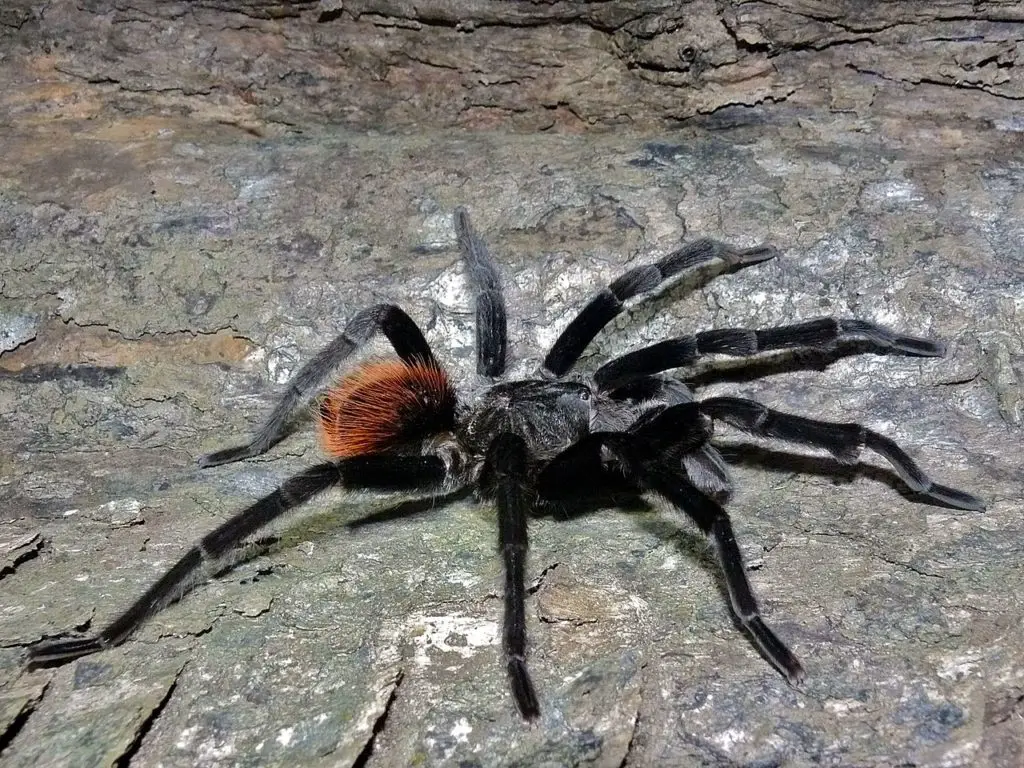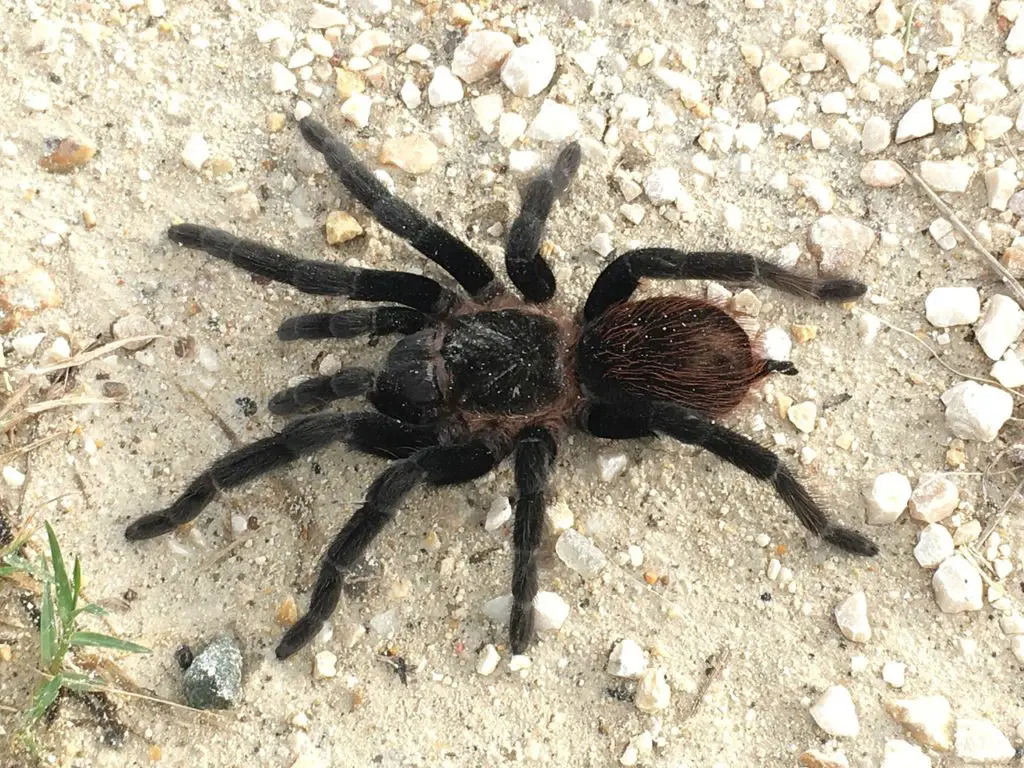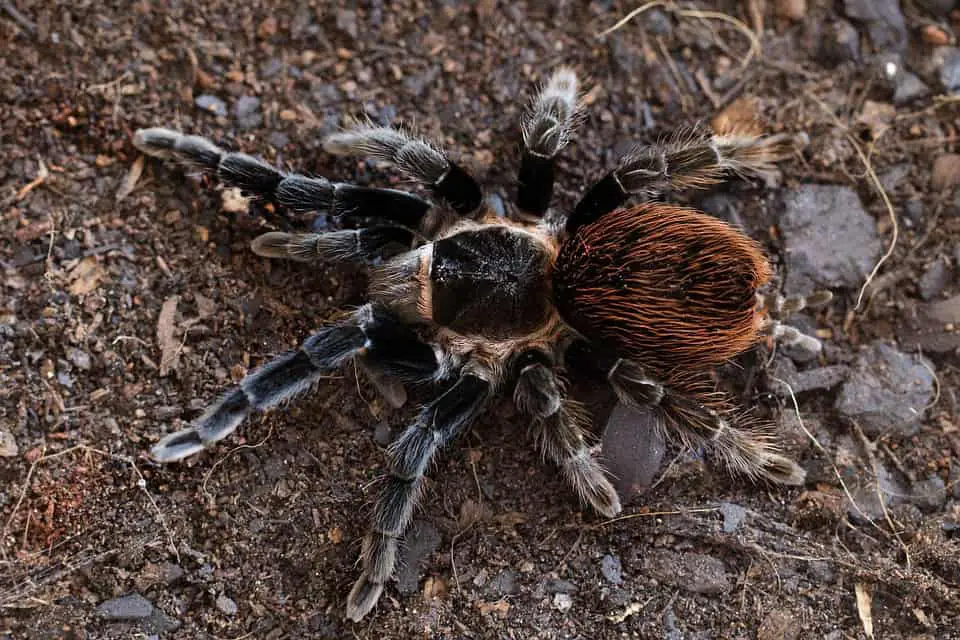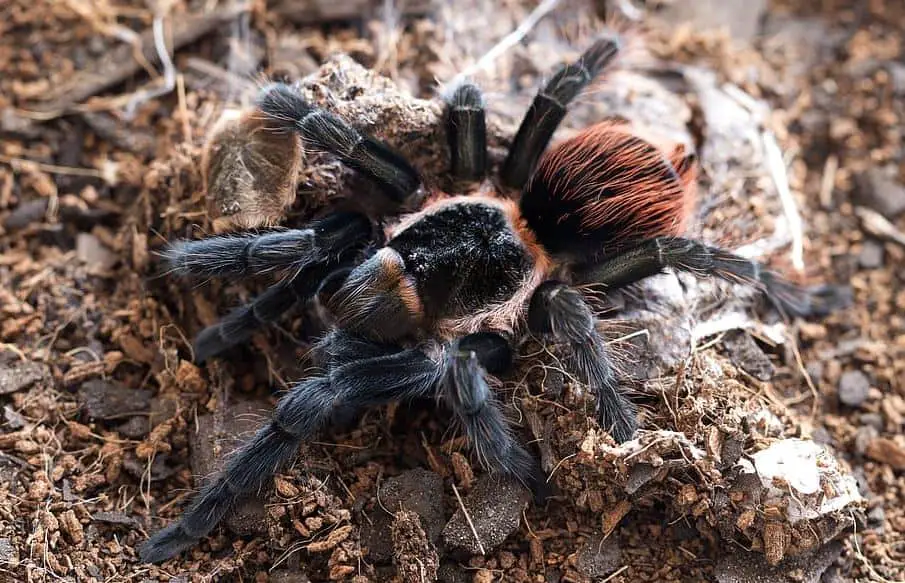The Mexican Red Rump Tarantula (Tliltocatl vagans) is a New World Terrestrial tarantula Originating in Central America, the Yucatan Peninsula, Mexico, and Florida.
They’re a popular choice as pets due to their bright red abdomen with a velvety black body giving them a stunning appearance. Not only that, but they’re also quite docile and easy to care for, making them very suitable for beginners to the hobby.
If you’re considering adding the Mexican Red Rump Tarantula to your collection, here is everything you need to know!

Mexican Red Rump Tarantula Care Sheet
| Name of species | Tliltocatl vagans |
| Family | Theraphosidae |
| Experience level | Beginner |
| Type | Terrestrial |
| Temperature requirement | 75 to 80 degrees Fahrenheit |
| Temperament | Relaxed, docile, calm |
| Color | Black with red hairs on the abdomen |
| Native location | Central America |
| Lifespan | Females: 25 years, males: 5 years |
| Growth rate | Medium |
| Urticating hairs | Yes |
| Size | 6 to 6.5″ |
| Diet | Insects: crickets, roaches, worms, etc |
| Minimum tank size | 5 to 10 gallons |
Mexican Red Rump Tarantula overview
The Mexican Red Rump, also known under its scientific name, Tliltocatl vagans, is a tarantula species that is native to Central America. This means that they’re a new world species. As such, they have urticating hairs which they use to ward off predators when they feel threatened.
This spider is terrestrial, which means that they spend the majority of their lives on the ground rather than in the trees.
Appearance & varieties

The Mexican Red Rump Tarantula’s name pretty much sums up their appearance. With a bright red abdomen, otherwise known as the rump, and black, velvet-like hair on their legs and head, they have a beautiful color that is easy to spot. With a body three inches long and legs up to 6 inches long, they are considered a larger species of arachnid.
There is a striking difference between female and male Red Rumps. Female Red Rumps are the larger of the two and live the longest, up to 25 years! On the other hand, males are smaller and only live 5-8 years, and that’s only if they can escape the hungry female’s fangs.
Most arachnid species molt, which is the process of shedding their exoskeleton to grow larger. Young spiders will molt around once a month and after they reach adulthood, will molt once a year or two. Don’t be alarmed if you see two tarantulas sitting in their habitat, one’s just the old shell making way for the new!
Behavior & Temperament
While large in size, the Red Rump has a docile and calm personality but is prone to mood swings. They are rarely aggressive towards their human owners, but they can do a threatening pose, in which you should leave them alone. If these spiders are threatened or provoked, they may bite.
Mexican Red Rump Tarantulas are venomous but not enough to harm a person. If you are bitten, you will feel a bit of discomfort but nothing to worry about unless you are allergic. Contact emergency services right away if you are allergic to your spider’s bite.
Most new world tarantulas have a unique body function called “urticating hairs”, which is where they throw off itchy, irritating hairs from their legs. The Red Rump’s hairs may cause itching and pain at the point of contact, but rarely need medical attention unless shot in the eye.
Most tarantulas are content with being left alone and are mainly solitary creatures. Mexican Red Rumps enjoy spending time in the open and if they are provided with a safe burrow that they can retreat in if they feel the need to, you’ll often see them relaxed above ground.
Price

Always be sure to go through reputable breeders when purchasing any pet. When buying, you can expect to pay anywhere from 50-100 dollars for a single spider. Due to their popularity, these estimates can vary. There are many online breeders that will ship your new spider to your home and local pet stores may have some in-store or be able to help you locate a breeder.
Of course, buying the tarantula itself is not the only cost. You will also need to buy an enclosure, bedding, and food. Luckily, these costs are relatively low, making tarantulas quite inexpensive pets.
Caring for a Mexican Red Rump Tarantula
The Mexican Red Rump Tarantula is quite easy to care for. Provide them with a suitable enclosure, good food, and a proper climate and they’ll thrive. Here’s everything you need to know to properly care for them.
Feeding
One of the reasons this tarantula is great for first-time owners is the simplicity of their feeding and habitats. While these spiders are carnivores and will eat lizards, frogs, mice, and birds in the wild if they can catch them, your domestic spider will enjoy a diet of crickets and roaches happily.
Red Rumps only need to be fed 1-3 times a week, depending on their age. You can change their diet up with crickets, roaches, locusts, or grub worms, just be sure to always provide fresh water. An important note, your Red Rump can feel threatened by your hand in their enclosure, so try distracting them with a tasty treat while you change out their water.
Tank size
As for their enclosures, it all depends on their size. Spiderlings, often called slings, can live in small enclosures while they mature. As they grow in size though, they should be transported into an appropriate size terrarium, and eventually move into a 5 to 10-gallon aquarium.
Substrate
The Mexican Red Rump Tarantula is a terrestrial species. This means that you will need to cover the bottom of the enclosure with substrate up to six inches so that adult Red Rumps can burrow. An example of a substrate that works well for these spiders is a mixture of sterile soil and coconut fiber. The substrate should be cleaned out every 1-2 months.
Humidity & Temperature
It is important to have 60-80% humidity in your spider’s tank at all times along with keeping the temperature at 75 to 80 degrees Fahrenheit year-round. If a tarantula becomes too dry or cold, it can be fatal for them.
To keep the humidity high, you can try dampening the substrate or placing a larger than usual water bowl in their enclosure so that the evaporation will increase the humidity.
Foliage & Tank Decoration
Adult Red Rumps will enjoy a few decorations in their home, such as a hiding house or a log. We recommend having a stick-type thermometer in their tank to consistently check the temperature. They don’t need constant heat lighting, so a simple dimmer lamp would be perfect. They love to hunt at night so be sure to give them some privacy when the house goes to sleep!
Health & Lifespan
The Mexican Red Rump doesn’t have many health issues! The biggest potential factor for health problems is the introduction of parasites into their habitats through their diet. As such, it’s important that you feed them high-quality captive-bred insects to ensure that they’re free of parasites.
In addition, with such fragile exoskeletons, tarantulas are at risk of falling from heights and breaking legs or even death. Be sure that your spider has the appropriate habitat to ensure a happy, long life. Also, if you choose to handle them do so very carefully.
Lastly, mold and bacterial growth are dangerous to tarantulas. Make sure that they have ample ventilation in their enclosure and that you remove uneaten food and shed exoskeletons in a timely matter. You could also choose to house them in a bioactive enclosure with small insects that serve as “janitors”.
If you keep these things into account, the Mexican Red Rump can have a remarkably long lifespan. Females can live for up to 25 years while males typically live for about 5 years.
Communal living
The Mexican Red Rump is not a communal species. They’re solitary animals that do not tolerate the presence of other tarantulas in their habitat. As such, attempts at communal housing will end in cannibalism and should be avoided.
If you’re interested in a communal tarantula setup you should only do so with species that are capable of communal living such as the Gabon Blue Dwarf or the Socotra Blue Baboon.
Quick facts about the Mexican Red Rump

There is so much to learn about any species and tarantulas have unique characteristics that make them fun pets and interesting to watch. We’ve rounded up some quick facts to further entertain you about these striking guys:
- Tarantulas have poor eyesight despite having eight of them! They instead rely on feeling vibrations in their legs to catch prey or warn off predators.
- While able to move like lightning for one to two times their body length, they are unable to move fast or jump over long distances.
- Female Red Rumps will mate with a male spider and if he is not quick enough, she will have him for dinner. It’s not easy being the male species in the spider kingdom!
- If you start when they’re young, you can get your Red Rump to be comfortable with being handled. Just remember, they’re fast and can easily jump from your hands.
- While native to Central America, a small group of Mexican Red Rump Tarantulas has been found in lower Florida! While probably brought there by accident, the group is watched by scientists for behavior and physical developments as the species adapt to its new environment.
Conclusion: Is the Mexican Red Rump the right Tarantula for you?
As the most highly recommended tarantula for first-time owners and simply stunning with its colors, it’s no wonder the Mexican Red Rump is rising in popularity! They’re easy to care for and are often called “show spiders” because of their enjoyment of being in the open. These little guys can be handled easily, making for great first-time pets.
With a large aquarium, substrate, crickets, and water, you’ll be ready to welcome your eight-legged friend into your home. You’ll definitely have a unique pet to show off to your friends and find many hobbyist groups to interact with. Don’t be afraid of their eight eyes and one-inch fangs, as tarantulas see humans as the larger predator and won’t seek us out for attack. Your fuzzy new companion will be fascinating to watch and interact with!
- How Long Do American Eskimo Dogs Live? Important Factors and Care Tips - September 29, 2023
- Do American Bulldogs Need Grooming? Essential Tips and Care Guidelines - September 29, 2023
- Do Bengal Cats Enjoy Playing? Essential Tips for Keeping Them Active - September 29, 2023